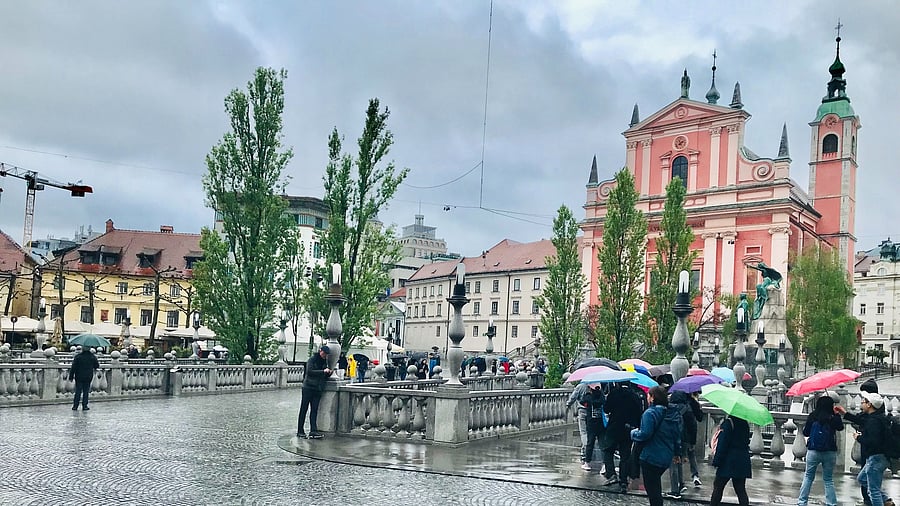
The salmon pink Church of the Annunciation.
Photo by author.
It may not be easy to pronounce Ljubljana but one can easily fall in love with this tiny capital city of Slovenia, nestled between the Alps and the Adriatic.
Nearly everything that one must see or yearns to see is walkable from the city centre, the reason why walking tours are so popular.
On a drizzly morning, we joined a motley crowd at the central square, chaperoned by our voluble guide, Helena.
Pointing to the ancient, salmon-pink Franciscan Church of the Annunciation, she walked us through its history and architecture before drawing our attention to a statue opposite the church. Cameras and selfie sticks went click, click.
Interestingly and somewhat intriguingly, the bronze statue of France Prešeren holding a book in his hand is in commemoration of Slovenia’s national, lovelorn poet. Behind him, seated on a column of rock is the figure of his muse, a semi-naked woman holding a wreath over his head.
Legend has it that Prešeren was madly in love with Julija Primic but unluckily for him, Julija married another man. The romantic Prešeren had several love affairs but never forgot Julija until the end. He wrote a lot of poems and one of them is the national anthem of Slovenia.
Just before moving on, our guide pointed out a bust of a woman on the wall of a house opposite Prešeren’s statue.
That is the bust of Julija, Prešeren’s real, live muse; he can now delight in her forever, she smiled.
“Oh, how sweet,” an old lady cooed.
As we walked along, she told us another titbit. Offended by the statue of the semi-naked woman opposite the church, the priests tried covering her with a cloth but when their efforts went in vain, they planted two trees to obstruct that view.
A few steps ahead and into a narrow cobblestone street is the Cathedral of St Nicholas, an 18th-century Baroque church. Unfortunately, the church was closed, denying us the chance to enjoy its lavish interiors with baroque-style frescos and portraits and its magnificent altar. We had to be content admiring its exterior, especially the ornately carved bronze doors embellished with scenes in high relief. On the main door at the bottom, there’s a little gold nose. Rub it for luck, coaxed our guide.
The river Ljubljanica with impressive bridges runs serenely across the city and is more than just photogenic. Its embankments with beautiful, old medieval buildings and lively cafés offering outdoor seating are the heart of the city’s social life.
Leisurely walks alongside the weeping willow-lined riverside are truly a cool experience to take in the charming ancient beauty at every twist and turn. No wonder the city’s inhabitants are grateful to architect Jože Plecnik who designed much of the old city centre.
Ljubljana could well be called the city of bridges. They not only tell its history but also lend the miniature city a certain character. From St Nicholas’ Cathedral we turned to arrive in front of the famous ‘Triple Bridge’ across the Ljubljanica River. The centre of the three bridges has stood in its place since 1842 while the other two bridges beside it came up around 1930. The bridges, meant only for pedestrians, connect the old town with the new, providing spectacular picture postcard backdrops.
Further up, a short walk away is the ‘Dragon Bridge’ with two imposing dragon statues at both ends and legends attached to them. Representing strength and courage, the dragon has become the symbol of the city and the country after the city’s first inhabitant heroically fought a dragon.
After a long walk, we landed on another interesting bridge called ‘The Butcher’s Bridge’ because it was built on the spot where butchers used to be. But today it can well be called the ‘Lovelock Bridge’ where couples’ love is immortalised with colourful locks, giving the bridge colour and love as our guide explained knowingly. The bridge also has some figures from Greek mythology such as Prometheus, sculpted by Bosnian Slovenian Jakov Brdar.
Day two was bright and sunny, making Ljubljana lovelier. We strolled along the streets, ogling at the Slovenian architecture and culture, a mix of Austrian, Italian and a bit of Slovenian touches.
The 15th-century Town Hall with its Venetian architecture and the University Library with its dramatic façade combining recycled bricks and stone blocks were sights to behold. Lack of time dissuaded us from visiting the city’s museums as well as the 11th-century castle that looms directly over the old town on a high hill.
But we didn’t skip the lively open-air market where Slovenes sell everything from fresh flowers, fruits, vegetables, herbs to shoes, souvenirs, clothes and crafts.
Ljubljana is not as crowded as some Western European cities. Home to around 3,00,000 inhabitants, the city became the capital of Slovenia after its independence from Yugoslavia in 1991. The city has been hit hard by several earthquakes over the centuries and rebuilt many times. So, unsurprisingly, its architecture today is a mix of different styles from Renaissance to Neoclassical and Art Nouveau.
However, what’s most impressive about Ljubljana is that it is green and clean. The city’s green credentials are well known, it was named Europe’s Green Capital in 2016.
It is placed at the very top in Europe in terms of green surfaces per inhabitant and one cannot miss the environment-friendly sightseeing train named ‘Urban’ plying across the city all day with tourists.